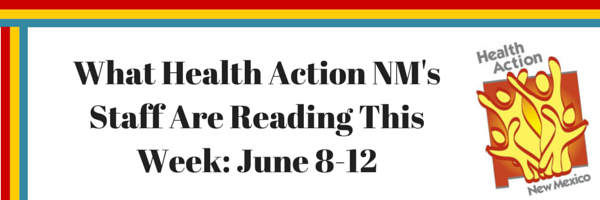What Health Action NM's Staff Are Reading This Week: June 8-12

The Department of Health and Human Services releases new enrollment data for New Mexico. As of March 31st, 44,085 individuals are enrolled in New Mexico Health Insurance Exchange (NMHIX) plans, 33,244 of whom qualify for premium tax credits and 21,149 of whom qualify for cost sharing subsidies. The average premium tax credit in NM is $200.
There are 5 tiers of health plans that consumers can choose from, each of which covers a certain percentage of the cost of care. Catastrophic plans cover less than 60% of costs, Bronze plans cover 60% of costs, Silver plans cover 70% of costs (but up to 94% with cost sharing reductions), Gold plans cover 80% of costs, Platinum plans cover 90% of costs. Enrollees can access cost sharing reductions only if they purchase a Silver plan. Here’s a breakdown of how New Mexico compares to the nation as a whole:

There is still a great deal of work to do to get people living in New Mexico who are eligible for benefits enrolled in NMHIX coverage. Only 33,244 of the 118,000 New Mexicans who are eligible for premium tax credits have taken advantage of this opportunity. Health Action NM will continue to track the implementation of health reform and work to raise awareness about new options and benefits in hard-to-reach communities.
- Barbara Webber, Executive Director
New Mexico is safe from a negative King v Burwell ruling. This month, the Supreme Court is expected to release a ruling on a lawsuit alleging that consumers in states with federally-operated health insurance exchanges aren’t eligible for premium subsidies. New Mexico is in a special situation in terms of the lawsuit since our state has established an exchange but continues to use the federal web portal, known as healthcare.gov. The Centers for Medicare and Medicaid Services has consistently affirmed that New Mexico is classified as a state-based exchange, meaning that we will be protected from an adverse ruling. Health Action NM has reached out to legal experts to confirm this. Consumers in New Mexico can rest assured that subsidies will remain in place regardless of the outcome of King v Burwell.
- Colin Baillio, Communications and Outreach
Americans use less care but pay way more than other industrialized countries. Many claim that the reason health costs are so high in America is because Americans visit the doctor too much. But new data show the exact opposite - Americans utilize services less than any other industrialized country with the exception of Switzerland, which has system similar to the US. The real problem: extraordinarily high prices. Americans are charged much more for services than those in any other country. Here are some highlights from the most recent study:
- Along with Switzerland, the U.S. has the fewest physician consultations per capita among higher-income OECD countries. Consistent with this lower physician use, the U.S. also has fewer physicians per capita and about one in every ten adults (11%) report that they either delayed or did not receive needed medical care due to cost in 2013.
- U.S. patients on average experience shorter hospital stays than in other OECD comparable countries.
- The U.S. performs fewer angioplasties and more coronary bypass surgeries than comparable countries, but for both procedures prices are substantially higher than in other countries where data are available. According to the International Federation of Health Plans, the national 95th percentile average for an angioplasty in the US is $61,184.
- The average price per coronary bypass surgery in the U.S is 2.4 times higher than in other countries where data are available.
- The average cost per Caesarean section in the U.S. is 1.7 times higher than in comparable countries where data are available. Normal delivery in the U.S. averaged $10,002 in 2013.
Prices for nearly all services are remarkably high compared to similar countries. Despite high prices, quality outcomes remain lower than other industrialized countries. This trend is even worse for uninsured consumers, who are regularly charged up to 10 times the rate of those with insurance. Health Action NM will continue to keep an eye on this trend and what can be done to limit adverse effects on consumers.
- DeAnza Sapien, JD, Advocacy Coordinator
Hillary Clinton will make substance abuse and mental health treatment a priority in her presidential campaign. Clinton has made clear that drug abuse and mental health issues should be given the same attention as any other chronic disease. Her policy advisors are reaching out to stakeholders to gather input on how to craft effective policies to address the needs of patients with mental health and substance abuse disorders. Clinton stated that adequate funding to treatment facilities and insurance coverage of addiction treatment are often not priorities in our current health care framework. Although the ACA classifies substance abuse treatment and mental health services as essential health benefits, the issue of access for these remains, as patients who seek treatment are often unable to. The ACA plays an important role in shifting the perception of mental health and substance abuse issues from neglected aspects of overall wellbeing to a fundamental part of our health care system. New Mexico’s population would greatly benefit from increased support for these services and Health Action will continue to advocate for greater access.
- Andrea Andersen, Health Policy Intern
Former insurance executive Wendell Potter says the American health care system is not the best in the world. Americans are big spenders on health care, but our outcomes don’t seem to reflect it. We fall far behind in important categories like life expectancy and infant mortality rates compared to every other developed country in the world, but we continue to buy into the idea that the more money spent, the better health care we receive. Unfortunately, our system is more often dictated by insurance and pharmaceutical companies, than the needs of our people and this has dangerous consequences for our health and our pocketbooks. Our system lacks the policies needed to help protect consumers from the high costs set by drug companies and providers that our insurance carriers inevitably pass down to us. It’s time for consumers to start demanding more accountability and transparency of our health care dollars.
- Ellie Perkins, Health Policy Intern
Health Action



